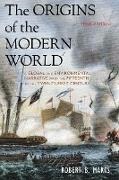Read more
This clearly written and engrossing book presents a global narrative of the origins of the modern world from 1400 to the present. Unlike most studies, which assume that the "rise of the West" is the story of the coming of the modern world, this history, drawing upon new scholarship on Asia, Africa, and the New World and upon the maturing field of environmental history, constructs a story in which those parts of the world play major roles, including their impacts on the environment. Robert B. Marks defines the modern world as one marked by industry, the nation state, interstate warfare, a large and growing gap between the wealthiest and poorest parts of the world, increasing inequality within the wealthiest industrialized countries, and an escape from the environmental constraints of the "biological old regime." He explains its origins by emphasizing contingencies (such as the conquest of the New World); the broad comparability of the most advanced regions in China, India, and Europe; the reasons why England was able to escape from common ecological constraints facing all of those regions by the eighteenth century; a conjuncture of human and natural forces that solidified a gap between the industrialized and non-industrialized parts of the world; and the mounting environmental crisis that defines the modern world. Now in a new edition that brings the saga of the modern world to the present in an environmental context, the book considers how and why the United States emerged as a world power in the twentieth century and became the sole superpower by the twenty-first century, and why the changed relationship of humans to the environmental likely will be the hallmark of the modern era--the "Anthopocene." Once again arguing that the U.S. rise to global hegemon was contingent, not inevitable, Marks also points to the resurgence of Asia and the vastly changed relationship of humans to the environment that may in the long run overshadow any political and economic milestones of the past hundred years.
List of contents
List of Figures and Map Preface to the Third Edition Introduction: The Rise of the West? Chapter 1 The Material and Trading Worlds, circa 1400 Chapter 2 Starting with China Chapter 3 Empires, States, and the New World, 1500-1775 Chapter 4 The Industrial Revolution and Its Consequences, 1750-1850 Chapter 5 The Gap Chapter 6 The Great Departure Conclusion: Changes, Continuities, and the Shape of the Future Notes Index About the Author
About the author
Robert B. Marks is Richard and Billie Deihl Professor of History at Whittier College and the author of our just-published China: Its Environment and History and Tigers, Rice, Silk, and Silt: Environment and Economy in Late Imperial China (CUP 1998). He received Whittier College's Harry W. Nerhood Teaching Excellence Award in 2000.
Summary
Now in a new edition, this clearly written and engrossing book presents a global and environmental narrative of the origins of the modern world since 1400. Robert Marks constructs a story in which Asia, Africa, and the New World play major roles and points to the resurgence of Asia and the vastly changed relationship of humans to the environment.

